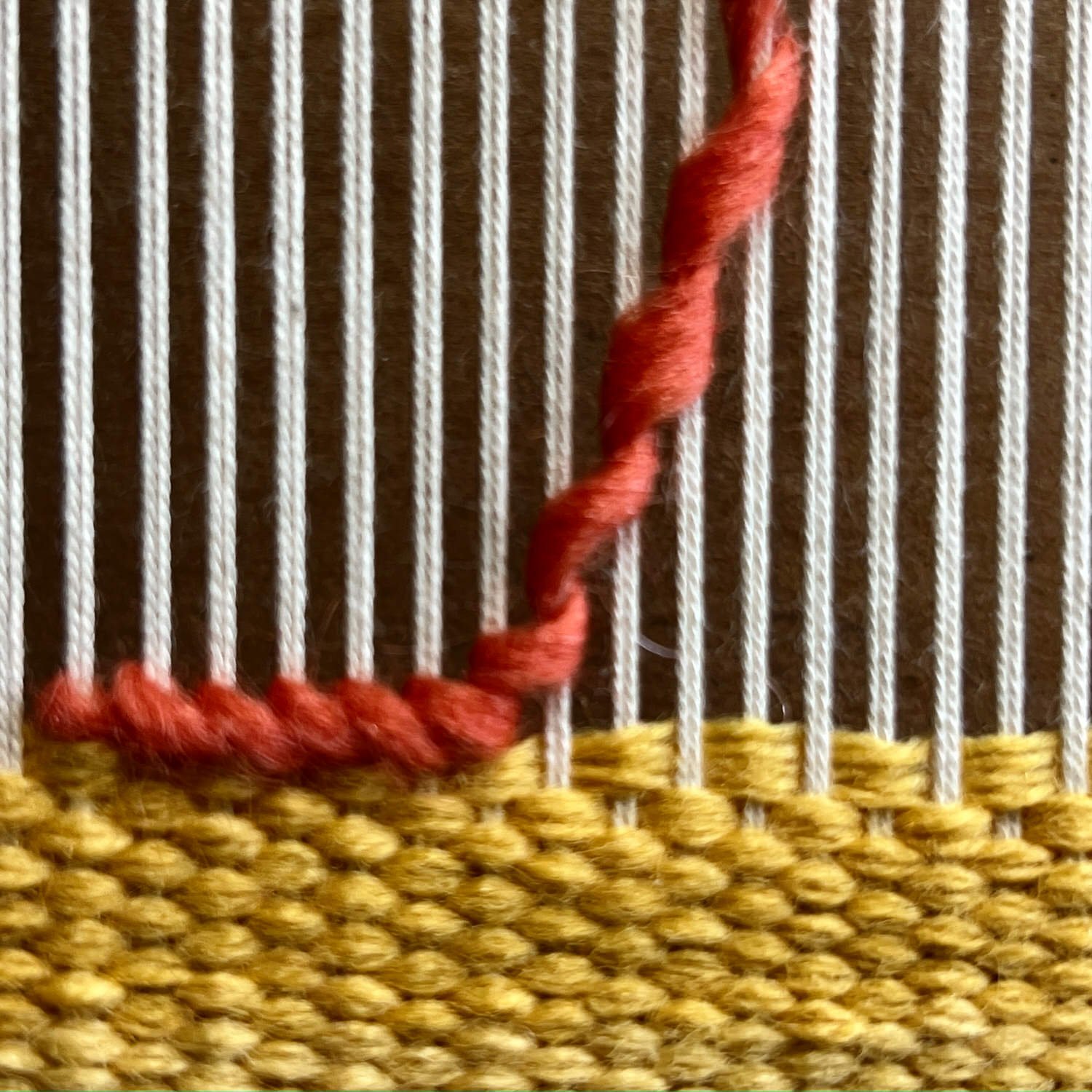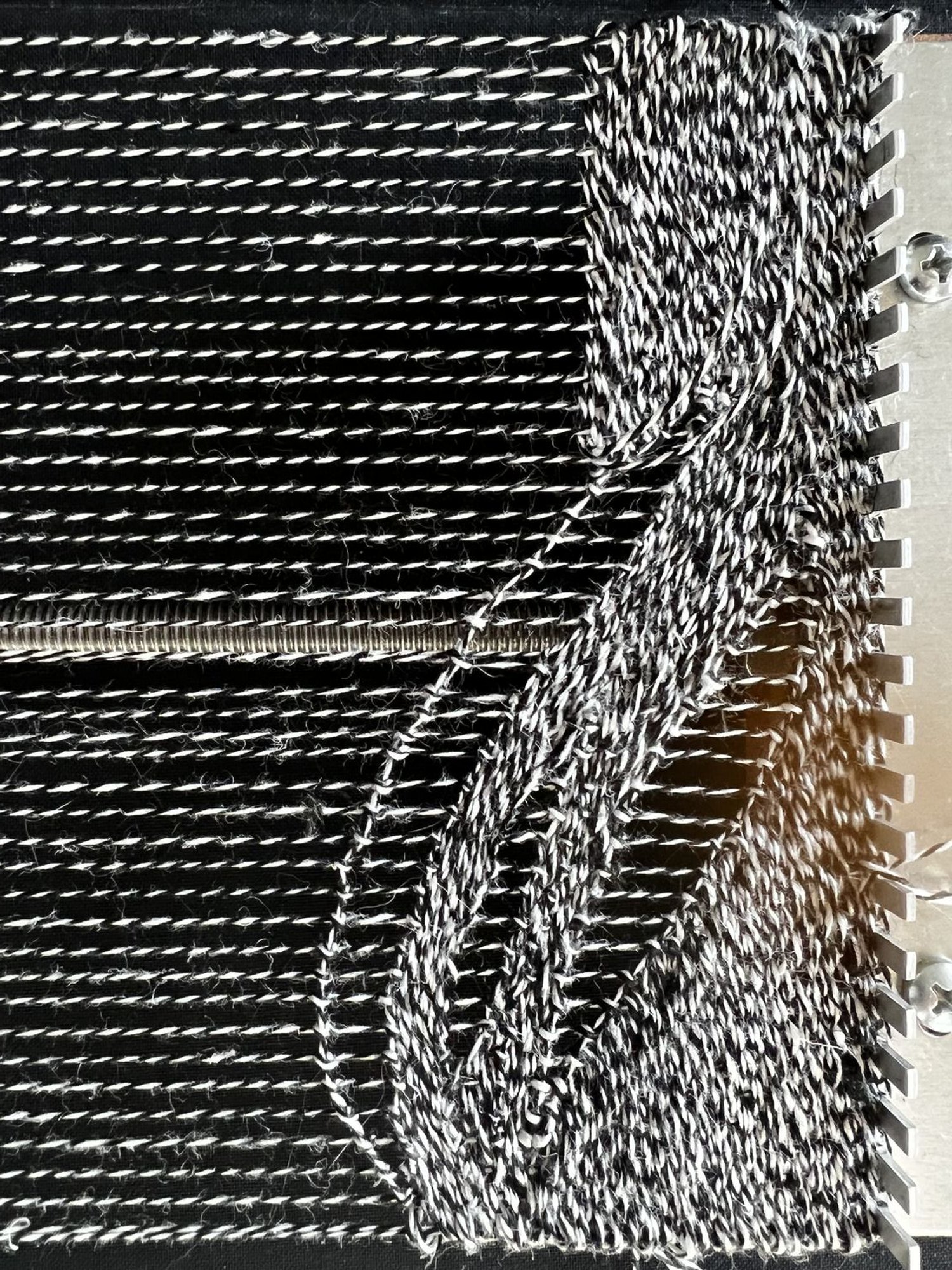Adding Texture to Tapestry
The photo above is a detail of my "Tree Companions", where I used a double warp of 4 EPI for the lower orange-rust rounded area by going over 2 and under 2 warps and 8 EPI for the rest of the tapestry. It also uses a contrast of textured and smooth yarns throughout.
Texture can be created in tapestry in a number of ways.
Of course, the nature of any textile work is textural. However, there are many options available for additional texture in tapestry, from the materials we choose to the specific technique. Some of these are Rya knots, Soumak, Eccentric weaving, Twining, Open Warps, and Supplementary Warps. There are many others.
Materials
The choice of weft fiber can make a big difference in the texture of a tapestry surface. For example, wool can be smooth or coarse, fine or thick, crimped, and so on. Cellulose fibers can be both smooth or textured and add an extra sheen. Man-made fibers can also be made into a range of textures.
The sett of the weaving plays a role in the overall texture, too, and the relationship between the sett, the warp used, and the weft. Warping at two setts or supplementary warps gives an additional option to add texture.
Texture created using a novelty “netting” yarn as weft and secured with nettle. Image taken from “Texture in Tapestry” class - created by Lu Fiskin-Ross.
Using different materials in a weft or weft bundle will also create another textured effect. In addition, unusual or non-fiber materials, such as feathers, sequins, and beads can add another layer of texture.
Warp, too, can play a role in the texture of a tapestry. In traditional tapestry, the warp is covered, so the texture does not usually show on the surface. However, in non-traditional methods, open warp areas are left with no weft and create areas of interest in their contrast of texture to the rest of the piece.
Specific Techniques to Create Texture
Soumak
Soumak can be used for outlining, to maintain warp spacing, and to fill in areas with texture. It can also cover up little bits of lice, strengthen a selvedge, and stabilize the warp. Soumak has many variations. One of the simplest and most versatile is Closed Soumak.
Closed Single Soumak
To work Closed Soumak
Closed Soumak worked left to right will slant to the right; worked right to left, it will slant to the left.
Working left to right:
Begin with securing the yarn to the edge warp with a pigtail or knot.
Take the weft yarn over the next warp thread, then back behind it under the weft float, coming out between the 1st and 2nd warp threads.
*Bring the weft yarn over the next 2 warp threads (including the one just wrapped) then back behind one warp thread and under as before.
Repeat from * across the fell line.
At the edge, the last warp can be wrapped or a couple of picks can be woven over the last two warps.
Work right to left in the same manner, moving in the opposite direction.
Pile Weave detail from “German Fields”, Kennita Tully
Knots- Ghiordes Knot (also known as Rya)
Knots are a great way to add texture. In the Ghiordes knot, lengths of yarn are wrapped around two warp threads. The knots can be made with pre-cut lengths of weft or with a continuous weft. The knots can cover just a single area or all-over. If knots are wrapped from selvedge to selvedge, 2 or 3 warp threads at each selvedge should be without knots to provide the ground weave for the edges and between rows of knots.
Pre-cut lengths of weft will be more time consuming, but if you are changing colors from one knot to another, it is the only method. If weaving areas with the same weft - or bundle - the knots can be continuously made. This is a good method to use if different lengths or effects are desired. The loops can be left as is or cut to form the pile.
Another method if using the same weft for a larger area is to wrap around a dowel or similar object. This is helpful not only in speed, but also in keeping the length uniform. The dowel can be pulled out and loops cut with scissors - or left in and cut with a razor blade or ex-acto knife while the dowel is still in.
detail, open warp, in progress
Open Warps
Another way to create texture is to leave open areas in the warp. These can be secured with double half hitches to keep from moving around. They can be left exposed, or later woven into with other materials, such as feathers or found objects, textured yarns, etc.
The materials for the warp is probably the biggest concern in this method. Something other than your normal choice for warp might work better, depending on the effect you are after. Colored cotton or linen warps are available or you may want to work with something completely different, like stainless steel, paper yarns, or wire. You could also paint the warp threads with special fabric paints. My favorite is Tsukeniko fabric ink.
Other Techniques
In addition, texture can be created in other weave structures such as twill or by going over and under two or more warp threads instead of one in some areas as in the image at the beginning of this post. By combining textured yarns with special techniques a lot of variety can be achieved.




